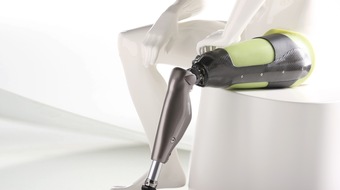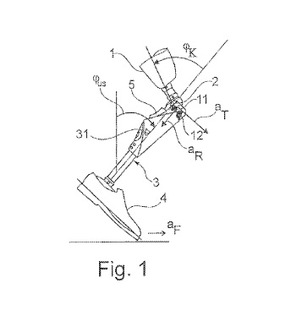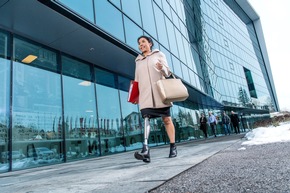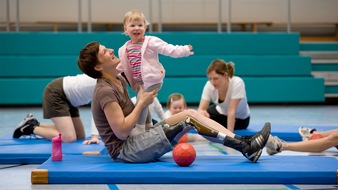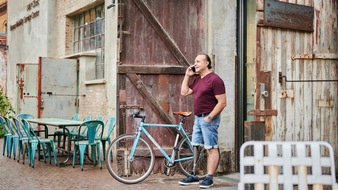Natural gait – new Ottobock patent simplifies prosthesis control
New measuring technology, sensors or interfaces – advanced technology is often behind changes that are barely noticeable to the naked eye. Patents ensure the appropriate recognition of the scientific effort behind them. The health tech enterprise Ottobock was recently granted a patent for a simpler sensor system to control prostheses and orthoses.
World Intellectual Property Day
Natural gait – new Ottobock patent simplifies prosthesis control
New measuring technology, sensors or interfaces – advanced technology is often behind changes that are barely noticeable to the naked eye. Patents ensure the appropriate recognition of the scientific effort behind them. The health tech enterprise Ottobock was recently granted a patent for a simpler sensor system to control prostheses and orthoses.
22th April 2021
"I was pleased about the patent. But for me personally, the emotional impact is most important," says Dirk Seifert, Development Engineer. "My eureka moment was when the first individuals used the system to walk and were excited, telling me it felt better than anything they had ever used before." He worked for one and a half years with his team of researchers and developers to simplify the sensor and control concept. It is used in prosthetic knee joints and leg prostheses such as the C-Leg 4, in orthoses such as the C-Brace 2 and perhaps also in exoskeletonsin the future. There are fewer individual components for O&P professionals to plug and screw together as a result, making assembly less prone to error and reducing the required effort. Users can walk more easily and naturally with this system.
Ottobock is celebrating US patent US10945863, its most recently issued patent, on World Intellectual Property Day. World Intellectual Property Day, established by the World Intellectual Property Organization (WIPO), is held on 26 April 2021. "When nurtured and enriched with ingenuity, know-how and flair, an idea becomes an IP asset that can drive business development, economic recovery and human progress," WIPO writes on the website.
What the new patent for the Ottobock knee joint is about
The patent was granted to Ottobock in the spring of 2021, exactly 30 years after the first C-Leg patent was registered and 25 years after the original C-Leg patent for prosthesis control was granted (US 5571205). The C-Leg is a prosthetic knee joint for people who have lost their leg due to an accident or an illness such as cancer. A microprocessor transforms the information collected by the sensors into control commands that adjust the gait, for instance on stairs, level streets, inclines or hills. The basic patent for the fourth generation of the C-Leg describes the next level of prosthesis control. The innovation is that control is now based solely on measuring movement, rather than using numerous and comparatively expensive force sensors to measure the load on the prosthesis and the bending moments. Prosthetics and orthotics would be unthinkable without movement sensors, especially inertial measurement units. They are also used in smartphone applications such as activity trackers: "We adopted this technology very early at Ottobock. With the C-Leg 4, we have managed to rely exclusively on this movement sensor system for the first time," Dirk Seifert says.
These kinematic sensors capture all necessary geometric movement characteristics at one central point: How is the prosthesis moving in space? How are the thigh and lower leg moving relative to each other? This reduces the measuring effort, improves the robustness and makes the prosthesis more streamlined because additional sensors with screw or plug connections are eliminated. Thanks to this detailed movement information, the joint knows exactly what gait phase and activity is currently ongoing. When walking on a soft forest floor, for example, the force measurement is less clear than on asphalt. This inaccuracy is eliminated when kinematic measurement data are used exclusively. Since wearers are able to control their movements more easily than the forces acting on the prosthesis, the new sensor system means they are able to walk on various surfaces more easily and naturally.
Dirk Seifert describes the development process behind the patent like this: "Those are truly beautiful moments that you remember for a long time. At first you have an approximate idea of how something could work. Then you collect data, build the first prototypes and have some minor setbacks. Things come together piece by piece, forming a picture and then you have a breakthrough. It's a fascinating process!"
Ottobock is one of Germany's most innovative companies
Dr. Andreas Goppelt, Chief Technology Officer of Ottobock, says: "I am proud that our high innovative strength is supported by numerous patents. Three criteria allow an idea to become a patent: It must be new, inventive and commercially applicable. Not all ideas lead to a patent. And because we invest high expenditures in research and development that helps people with disabilities live a normal life, property rights are an economic foundation of our industry." Ottobock, the technology leader in wearable human bionics*, submits about 200 patents around the world each year. The company held 1886 patents in more than 540 patent families at the end of 2020, including technical innovations in the prosthesis, exoskeleton, orthosis and wheelchair segments. In 2020 alone, 47 initial patent applications were submitted. The business magazine Capital recently recognised Ottobock as one of Germany's most innovative companies. The company has a patent portfolio of particular technological relevance, as the internationally recognised patent analyst PatentSight noted in the Capital article.
*Wearable human bionics replace or extend a part of the human body.
Maja Hoock Public Relations Managerin Ottobock SE & Co. KGaA, Prenzlauer Allee 242, 10405 Berlin Telefon: +49 30 403 639 446 E-Mail: maja.hoock@ottobock.de
